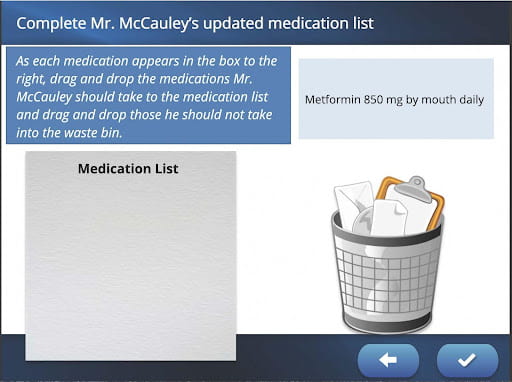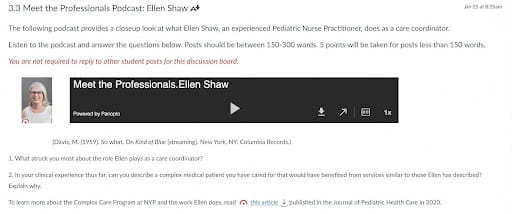
Dr. Karol DiBello, DNP, FNP-BC, ACHNP
Associate Professor of Nursing at Columbia University School of Nursing
Dr. DiBello teaches the Care Coordination course required for all Master’s Direct Entry (MDE) pre-licensure nursing students. It is taken in the last semester of a four-semester long, accelerated program in which individuals who have degrees in other fields are provided the necessary education for entry into nursing practice with a master’s degree. While Dr. Dibello had received a Provost Innovative Course Design Award in Spring 2020 and was planning to redesign the Care Coordination course, the pandemic required the changes to happen more quickly. Dr. DiBello met the moment by flipping her course, rethinking opportunities for student engagement, and using collaboration to support student learning. Read on to learn more about what Dr. DiBello did in her course, what lessons and experiences she’s carrying forward, and the advice she has for other instructors at Columbia. To hear more about Dr. DiBello’s innovations in her own words, watch her 2022 Celebration of Teaching and Learning Symposium presentation.
Flip the Course
As part of the Provost grant, I planned to flip the classroom. Without a textbook written for care coordination, I became a curator of knowledge. I looked up resources and curated what I knew was out there, what was available, what the science was, and linked the resources for my students. I broke up the CourseWorks (Canvas) modules with other modes so students are not just reading text (see Figure A). I did this based on how I learn and how I know many others learn. Some students might like lectures and think that’s how they learn because that’s how they’ve always gotten their information, but the science shows us that there are other ways to learn.
At first, I spent a lot of time getting content into the CourseWorks course site. I was working many hours, many weeks, many days trying to get it all in quickly, meaningfully, and I wanted it to look good. The science of nursing continues to evolve, so with each time I teach the course, I update the content, which is fun for me. I am working now on ways to reiterate the information that’s in the modules in the classroom without lecturing.
It was also important to orient students to the CourseWorks (Canvas) site. I have a whole pre-module that students complete before their first module and before they come into class. I explain how students will be assessed and why I think it’s important. I want them to know what the structure of the class is so there are no surprises when they are assessed. I want to get them starting on the right foot. Every module is set up exactly the same way so students know what to expect (see Figure B).
But this flipping takes time–don’t underestimate how much time it takes to prepare a flipped class. It’s an enormous amount of work and the work doesn’t really stop once the course begins. It just keeps going. I know that most will look at what worked and what didn’t work, and will try to fix it as they go along, so it does take quite a bit of work.
Rethink Opportunities for Student Engagement
I think that engaging 200 plus students in a remote environment can be really challenging, and it’s something I still think about a lot. I explore engagement options, and I try different things. To engage students, I include quizzes and discussion boards in the middle of each CourseWorks (Canvas) module. In-class time is spent more on working with the material, getting to know more deeply the information that students have completed before they come to class. I use Kahoot and other tools to get students to let me know whether they know the information or not, or if they reviewed it in the Ambulatory Care class. This has actually worked because students enjoy doing them, and it makes responding to questions more of a game. After each question, we stop and talk about it for a minute: Why is that the right answer? And why is that the wrong answer?
Additionally, students don’t have the opportunity to have Care Coordinators sit in front of them and to hear about areas of work that they don’t know much about. I interviewed a number of nurses in the field (e.g., nurses at the Mayo Clinic in Minnesota) and shared the recordings with my students through podcasts I call “Meet the Professionals” (see Figure C). They can listen to podcasts on the train on the way to school. It’s a good way to introduce them to people who are doing the work. There is a difference between the didactic presentations on what the science says and listening to people share the actual challenges they face on the daily basis–and the rewards. It means a lot to students.
Use Collaboration to Support Student Learning
I have my students complete several collaborative exams. I started using them mostly during the pandemic but it was something I was interested in doing all along. I think memory is fickle. It takes students out of “I need to memorize all the answers.” Students get anxious when they hear the word “exam.” My exams are open book and I ask students to find information on websites, the links to which are provided. I want them to look at data and to know how to look up stuff. The expectation for the collaboration is that they will look at information, and then get together as a group to talk about the answers to the questions. My classes are large. I want students to do the right thing. When we do exams, I tell my students that I made really great grades in Nursing school. I studied, I memorized everything, and I remember a thimble from all of my pediatric nursing classes. So to me, having a conversation with others about a topic makes it more memorable. The students learn from each other. I’ve had students tell me that they actually learned a lot from taking collaborative exams.
Now, other colleagues of mine in the School of Nursing are looking into collaborative exams. One colleague has students do the exam individually first and then collaboratively allowing them to review with their peers.
I also talk to my TAs a lot. I ask them: “How do you learn? What is important to you? Did this work for you? And how can you see it being better?” This informs my teaching and changes to the course.
Advice for Instructors and the Future of Teaching at Columbia
Give students resources to support their learning.
I had this wonderful TA that created a document of all the resources that I listed throughout the CourseWorks (Canvas) site so that students will have access to those. I think that’s something I will probably always do, just because I think it’s important. I want my students to know where to find information and not get lost, whether they are going to the CDC website or looking up epidemiological data from the state, national or local levels. As a curator of knowledge, I’m going to share the resources and websites that I think are important.
Take the dive.
It revives your teaching. It’s invigorating! For me, the creative aspect of it and trying to figure out how to solve problems and not doing the same old things all the time, is really exciting. It makes teaching fun. It makes me wake up at 3:00 in the morning and ask myself, “What if I try this because…” and break out of that traditional box, the way I was taught. I think it’s important to reflect on how we learn, and think about how learning works. This helps us rethink our practices and align them with the science of learning. For example, often traditional exams reflect memorization, they don’t reflect learning, and so I want to figure out how to help my students learn and then assess what they’ve learned.
I recognize that flipping an entire course is a lot. I would say if there’s just one little piece that you can adapt, and just try something different, go for it. Make one small change and see what it feels like, see how much time it takes, and how the students receive it.
Adapt your approach to meet the needs of all learners.
I have had to rethink what I’m doing and consider universal design for learning in my approach. My assessments vary because I recognize that my students have different backgrounds and preferences. I think that when we look outside of the usual and teach in a different way we are able to reach our students, many of whom have experienced practices in their primary and secondary educations that have expanded beyond traditional ways of learning.
Schools need to invest in different instructional tools such as Articulate 360, which I use quite a bit. It allows for a different way of learning and assessing and it’s valuable to student learning.
We could step away from very monochromatic ways of teaching, and move into something that supports a diverse community of learners particularly in more traditional classes. You don’t have to flip an entire course like me. A colleague of mine said: “Karol, you don’t have to do everything that comes up in your imagination.” Somebody has to do it.

Figure A: Screenshot of an Interactive Learning Object created with Articulate for students to apply their knowledge and skills.

Figure B: Screenshot of CourseWorks Module for: Care Coordination and Transition Management.

Figure C: Screenshot a “Meet the Professionals Podcast” episode posted to CourseWorks.